The 25 year Marathon training plan
2013 Rock 'n' Roll San Diego Marathon

My First Marathon
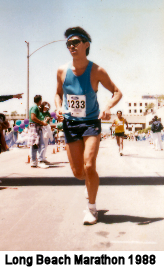
In 1988, on a dare, I started with no running experience, but completed the Long Beach Marathon. Training was minimal. Back then, I had been a bicyclist for a few years, and completed rides up to 100 miles. Physically in good shape and youth allowed me to recovery quickly from workouts. Training from scratch, and in only 16 weeks, with the first weeks mileage: 4, 6, 12, 16, 22. Maximum 29 (not including race week, which was 38). Only 2 to 3 runs per week, with one month over 100 miles. Only one weekly long run (starting on week 4) in chronological order: 10, 13, 13, 10, 13, 14, 10, 16, 20, 16, 13. My 20 mile long run went very well, and I averaged a 9 min/mile pace, and was aiming for a sub-4 hour finish. The first half of the Marathon went great with the clock at 1:55, right on pace. Somewhere around mile 16, my pace slowed, the pain started, and my mind went numb. At mile 18, the walking started, and my goal of a sub-four vanished. Mentally and physically I was drained. I was so relieved to cross the finish line and get my finisher's T-shirt (no medals back then). Completion time was 4:42:59. I remember telling my friend afterwards, "I'm never going to do another one of these again". Compare the picture (select to enlarge) at the Long Beach Marathon compared my finish below. This was taken about 400 yards before the finish line.
Recovery
It would be 40 days before I put on my running shoes again. The first run didn't go well, and I ended up only going 1.6 miles. A couple of weeks rest, and I try again going 6.2 miles. I remember having shin splits or something, and could only run once a week. After a month of failed attempts to start running consistently, I ended up giving up running for a few months to focus on swimming, which I would use on my next challenge: triathlons. I saw a doctor about my running injuries, and he suggested I just run short before any pain starts. So 5 months after the marathon, I was running again, but only 3 miles at a time. The slow build-up of mileage over the next several months allowed me to run the La Jolla Half Marathon the next year (12 months after the marathon), with my best time on this course (1:49:31). 19 months after my first marathon, in top triathlon shape, I signed up for the San Diego International Marathon. Even though I had not run more than 13 miles in a single training run, I figured my fitness level should carry me through the event. Needless to say, I had to drop out at around mile 16. The next several days I was limping in pain. From then on, I just figured I was not designed to run long distances. I just stuck to Half Marathons and Olympic distance Triathlons (10k run).
Becoming a Real Runner
I had never considered myself a runner. I never enjoyed running. Never felt good running (OK, maybe once or twice). Running was just part of the Triathlon that I had to get through. I'd always had injuries when running too much, or too long. In 2005, after about a 10 year break from triathlons (and running), I decided to get back into the sport. Of course that would mean running again. I may have tried running again once or twice during those 10 years, but it did not feel good, so why bother. I completed a sprint triathlon (only 5k run) in 2005, but continued to have injuries that kept me from enjoying running. Shin splints, IT band, knee problems, and other aches and pains were common. I wanted to run, other people run, why couldn't I run? It wasn't until I started barefoot running in 2010, that the injuries went away (because my form was better). With no down time, I enjoyed running and built up my running base. You can read how I got started barefoot running in my daily blog. After a year of barefoot running, and no major injuries, I was running a half marathon distance in training, and found running to be fun.
Another Marathon?
I had read about many barefoot runners completing marathons. If they could do it, so could I. In 2011, my second year barefoot, I completed several long training runs of 16 miles. The main reason I could not go further, was that my feet began to hurt. I also noticed that I had sore feet after mile 10 of most of my Half Marathons. In 2012, I wanted to challenge myself, and completed 8 Half Marathons, but in training, I could still never exceed a maximum of 17 miles in a run, or even 30 miles a week. Once I figured out that my sore feet were due to poor form when my muscles get tired, I practiced on form. I improved by running barefoot on rocky trails, but that did not help my endurance. Once I got tired, I just could not run properly. I reached a plateau, and didn't know what to do to go further.
Hansons Marathon Method
After reading the Competitor Magazine (September 2012) interview article with Luke Humphrey, author of the Hansons Marathon Method, I was intrigued. The long run was only 16 miles, I've run 16 miles, so I could finish a marathon? Of course there was a catch, those 16 mile runs simulate the last 16 miles of a marathon, and the body is fatigued before that run. This could be the solution to my dilemma, I was always starting my long runs fresh. I needed to train when tired, so I'll learn to run properly tired. Since the book would come out next month, I decided to use some of the techniques in the article and increased my running frequency to test the plan. In October 2012, I ran every single day of the month, and was slowly building my weekly mileage. By the end of the month, 40 mile weeks was the norm. I felt like this plan could work, and I could actually finish a Marathon, barefoot. My running form improved, especially when I was tired, and my feet were no longer the limiting factor. Now I just have to set sights on which Marathon. The Rock 'n' Roll San Diego was in June, allowing me to start training on the 18 week plan in late January.
Training for a Marathon
I had considered the Advanced Program after reading the book, since I was running 40 mile weeks since the end of October, but my body had trouble maintaining longer weekly distances through the winter. Muscle injuries, and catching a cold didn't help. The Advanced Program starts out with 40 mile weeks, but I wasn't putting in that much at just a month before the training plan was to begin. The beginner program seemed like a better fit. The first 6 weeks of the program are a slow build up of mileage, from 10 to 40. I was already doing 30, so I let the program catch up to my weekly mileage. I had run a 2:07 Half Marathon last year, so I projected that I could finish a Full in 4:30. The workouts are based on your projected finish time, and I had no troubles running the correct pace for the workouts, at least in the beginning. Six days a week running, so only one day off per week, but I had run 31 days in a row just a few months ago, so a rest day was nice. As the program got more intense, I had to cut back on my swimming and bicycling, and focus solely on running. As the weekly mileages climbed, and the runs fatigued my body, I found my pace each week slowing. At week 13 and 14, I worked two half marathons into my training plan. I was amazed at how well I was able to maintain a steady pace the entire run, and how good I felt at the end. I had my share of muscle pains, the first (a cramp) that caused me to reduce my intensity. The second (muscle strain) where I actually had to cut mileage, and even rest on a schedule run day. I could never get back to the required training pace for my predicted finish, and tried too hard, which put too much stress on my body. I was hoping that the taper would bring back my speed, but I was still recovering at that point, so I never felt fresh. Overall, I set all sorts of new mileage peaks. 226 miles peak month, 59 miles peak week, 740 miles in 18 weeks of training. Comparing this with my first marathon, 100 peak month, 29 peak week, 300 miles in 16 weeks, I was much better prepared this time.
Race Morning
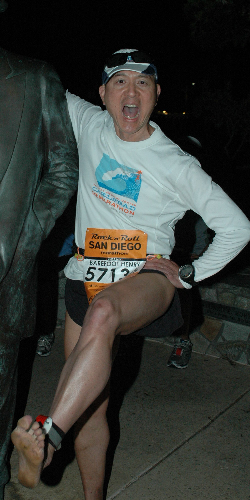
I had been so used to waking up at 2 a.m. for morning training runs, that even when I didn't have to I still woke up at that time. But today, I had to wake up at 2 a.m., so I set my alarm. I ended up waking up at 12:30 a.m. At 1 a.m. I decided I better get out of bed, since I was wide awake anyway. I did a few push ups and sit ups to warm up, had my PowerBar breakfast with 2 glasses of water. I got everything ready, and now it's 2 a.m. I headed downtown to park at the finish, and arrived just before 3 a.m. Plenty of parking spots, so I choose one close to the main exit street a little further from the finish line, but away from the congestion. Couples are still walking around on their night out, as I sat in my car using the free downtown Wi-Fi, waiting for 4 a.m. when the buses are suppose to take runners to the start. I didn't know exactly where the buses would be, but how hard can it be to find dozen of buses parked in the early morning. It was warm in the morning at 63°F, so I wandered off at 3:30 a.m. looking for the staging area, which I knew should be close to the baseball park where the finish celebrations will be taking place. I asked around, and finally found the row of buses. I was the 3rd person to board the first bus. The gentleman I sat next to was doing the Rock 'n' Roll World Tour, so San Diego was just another stop on his half marathon journey. The bus filled up before 4 a.m., and we were off to the start. We were the first people there, as even the volunteers had not all arrived. One of the benefits of getting to the start early, it that you are the first person to use the porta-potty. I found a bench to sit on, and struck up conversations with the other runners. The nice thing about the Rock 'n' Roll races, is that there are lots of people from outside San Diego. The sun rose, and I did my final preparations for the race start, which is basically one last potty stop, then drop off my gear. The potty line moved kind of slow, and I looked at my watch and it was 6:00, marathon starts at 6:15, and half starts at 6:45. I ran over to the gear drop off, since it was quite far away. The singing of the national anthem began while I was stuffing my clothes into my bag. I ran off to the start, which I was not even sure where is it. I found the entrance to my corral, and had to squeeze my way in. I was only there a minute or two, before we were moved forward. As we got to the start line, I realized I was right near the front, not my usual place (in back), but I could not change now. There were two timing bars, one at the start line, and another 10 feet back. I was reluctant to cross either one, and so were many others, but some were right up in front. There was kind of a gap between the two time strips that many do not want to cross.
The First Part
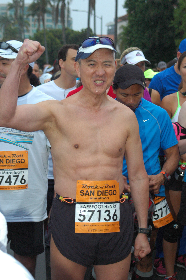
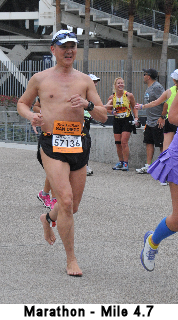
I started out and noticed something strange, not a lot of people were passing me. Maybe I was all warmed up from running to the start area, or everyone was taking it easy. At the first quarter mile (my watch beeps every quarter) I looked down at my pace, and I was running an 11 minute mile. OK, too fast, I'd better slow down. I had done a 10 mile tempo run at an 11 min pace, but I'm sure I couldn't hold that for 26 miles. I slowed a bit as people began to pass me. The first mile split was 11:30, and all my muscles feel great, none of the muscles that gave me problems during training were complaining, so I was thinking of holding this pace. I looked up ahead, and saw another barefoot runner, so I sped up and caught him, and we talked for a few miles (he was also running his first barefoot marathon). The first part of the course weaved through downtown, and there were lot of people cheering us on. Just after mile 5, we headed down Broadway which is a straight and smooth road and even more spectators. I would end up having my fastest mile split during that section at 9:23 minute per mile. Into Little Italy, and I have my first energy gel. I only brought a few, because there would be some along the course. After mile 7, we headed into a tunnel under the freeway, and it's dark. There are big lights lining the sidewalks on both sides and they lit up in sequence, giving the effect of a airport runway, along with the loud music (typical in a Rock 'n' Roll race) echoing off the walls. I almost stopped to take a picture, but to show off the effect it would be best to use video. At the first fuel station just before mile 8, and I grabbed 3 more GU. I was looking forward to mile 12, where the course runs along Mission Bay on the smooth concrete walk path. First we would have to get there, and the road gets slightly rough in sections, so I had to slow my pace down to 12:30. Just before mile 11, we make a right turn, and I looked down at road and see all the broken asphalt, and said "Really?". I looked ahead and realized this would only last two blocks, then the course turned left, hopefully on a cleaner surface. I do my best "dance" and get through probably the roughest section of the course. When we finally got to the smooth sidewalk at the park, my legs did not feel as fresh as I thought they would. I trained on some rough surfaces, but not for long stretches at a time. There was a slight pain on my inner left thigh, which I've never felt before in training. I tried running a bit on the grass, and even the beach sand, but that did not help. I had hoped to make up some time on the concrete, but decided that I'd better save my energy for the last part of the race. The porta-potty lines on the course had long lines, but I knew there are public restrooms along the bay would not have much of a line (if any), so I made my first pit stop (only a minute) and back on the course.
The Last Part
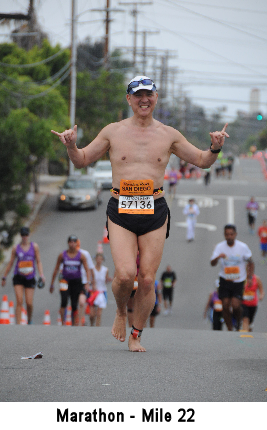
The weather was cool, with a slight drizzle near the bay, so I did not hydrate much, and had planned on making as few pit stops as possible. At the north turnaround just after mile 14, we left the smooth sidewalk and on to the street, and the rough asphalt. I knew this would last for a half mile since I have bicycled on this street many times. After a few 100 yards of this, I saw another runner on the grass to the right, and decided that was a good idea. I think it was about this time when I felt my quads getting tight which never, ever, gave me problems before. Slowing the pace further, now down to a 15 minute mile, to save my energy for the big climb on the freeway. The road finally smoothes out, but I'm still keeping the 15 min/mile pace. My quads do not seem to want to recover, and each mile they continued to be sore, regardless of the surface texture. Just before we enter the freeway, I see no line at the porta-potties, so I make one more stop since I know there won't be any for a few more miles. It was really hard to start again, as just that minute of not moving made my muscles even tighter. I try my best to get back to my original pace, but my legs just didn't seem to want to move fast. Other runners are starting to pass me more frequently now as my pace drops to 20 min/mile. As we began our ascent, I kept my running form, shorten my stride, and kept up the cadence. As much as my quads hurt, I knew I had to keep running, no walking, as a cramp at this point would put me out of the race. Only problem was that I was moving so slow (22 minute mile) that people were walking past me including the second barefoot runner I saw on the course. I kept focusing on my running form, just like during training, so my feet would feel great. The 250 foot climb was long and slow, the clock was already at 5 hours. I originally wanted to finished under 5 hours, but I knew my training did not justify that. I'd be happy if I went under 6, but I'd have to pick up the pace, and I knew that was not going to happen, either. At mile 21.5, we exited off the freeway, into a neighborhood, and the course flattened. My pace picked up slightly, but not much, as my quads were even more sore after the hill climb. There was a guy offering everyone bacon, and I was really tempted, but I didn't train eating bacon while running, and I still had a way to go before the finish. It seemed as if everyone passed me, and then another barefoot runner. I look back, just to make sure I wasn't the last one in the race. I continued consuming energy gels at a faster rate (about 3 to 5 miles), in hopes that it might give me the boost that I need. Surprisingly, I never hit the dreaded marathon wall. Some small rolling hills, before the downhill finish during the last 2.5 miles. Notice in the picture, Elvis (in a white jump suit) is behind me, and most are walking. I normally love to run downhills, but because my quads hurt so much, this no longer appealed to me. I had long given up finishing under 5 hours, and even under 6 hours did not look promising. At least I should be able to go under the 7 hour cut-off. I kept smiling for the photographers and acting silly. I really felt great overall, except for my quads. People were getting scarce at this point, both runners and spectators. The half marathon was long over, and there were only about 150 people behind me (6484 official marathon finishers). With the finish line in sight, and the final quarter mile I picked up the pace to a 16 minute mile, but there was no danger of anyone passing me, or me passing anyone because the runners are spread pretty thin by then. The finish announcer calls out my name to the few dozen people (really, notice the picture at the finish) still hanging around. I received my medal, and met another barefoot runner who had hung around to take a photo with each of the barefoot runners after they finished.
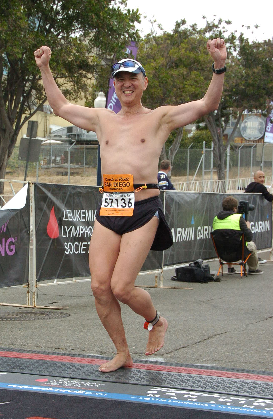
Celebration
Vendors were cleaning up their booths so there wasn't much food left, a volunteer handed me a fruit smoothie, and I grabbed a few bananas. One of my friends needed a ride back to his car, so at least I had one person to talk to as I headed home. Mentally, I never felt better after a race. I set a goal, and accomplished it. Even if I didn't meet my projected time, I never had any doubt that I would not finish. Next time, and there will be a next time, I know what obstacles I need to overcome. I won't wait another 25 years, but likely no more this year. I really need to focus on my speed, as I like finishing in the middle of the pack as I do in half marathons. Actual finish time was 6:40:54, but three of the other barefoot runners I saw were also over 6 hours, so I don't feel too bad. Over 1000 runners did not finish the marathon.
The Days After
My quads were very sore the next day. I was able to walk (slowly), but sitting took some help with the arms. Nothing else seems to hurt, which is great. By Tuesday I could get up out of a chair easily. Wednesday, I went for a short 3 mile run. The fact that I wanted to run so soon after my marathon was a big improvment from my first marathon.